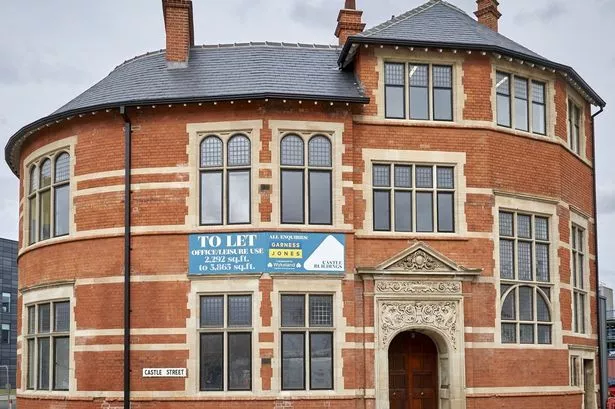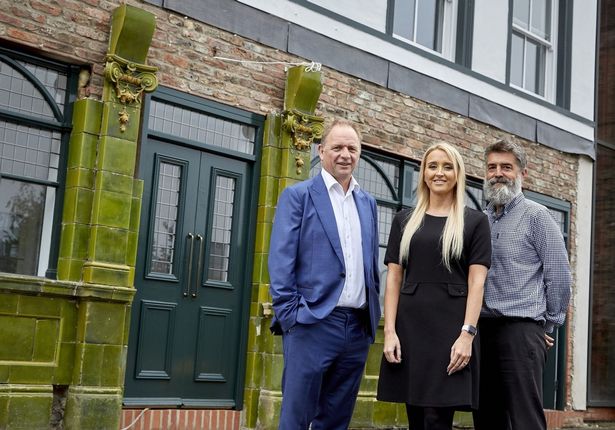
Iconic buildings are some of best-known in Hull, but how much do people know about their past
Castle Buildings is one of Hull’s most distinctive landmarks. With its striking curved frontage and Renaissance Revival architectural style, it overlooks the A63 Castle Street and has recently undergone a huge rejuvenation, also now incorporating the city’s iconic Earl de Grey pub.
The project has seen extensive structural repairs, a new roof and all the windows replaced with authentic, double-glazed reproductions. Inside, original parquet flooring, wrought-iron columns and mosaic entryway flooring have all been retained and refurbished, reversing decades of decline.
Wykeland Group has been responsible for the transformation of Castle Buildings, working with partners including Hull-based Voase Builders, Hessle-based LHL Group and Grimsby-based ID Architecture, to bring it to fruition. With the restoration project nearing completion, and public realm works surrounding Castle Buildings now taking place, Wykeland recently welcomed in members of the business community and public to explore the newly-renovated landmark, becoming the first visitors in decades.
While the Earl de Grey and Castle Buildings are perhaps among the best-known buildings in the city, how much do people really know about their colourful history? Below are just some of the interesting facts about them.
1830s
Originally known as the Junction Dock Tavern, the Earl de Grey public house was constructed in 1831 on Castle Street, an area of Hull built to service the docks which included a number of offices, warehouses and drinking establishments.
1860s
The pub was renamed in 1863 after George Frederick Samuel Robinson, Hull MP and the 1st Marquess of Ripon and Viscount Goderich. He was appointed the honorific position of the High Steward of Hull and inherited the title of Earl de Grey – giving the pub the name we now know.
1900s
In the early 1900s, Castle Buildings was constructed on the neighbouring land. The buildings housed offices for Messrs G R Sanderson, local steamship owners and brokers, and replaced earlier buildings on the site.
1910s
The Earl de Grey underwent a number of modifications over the years and it is thought that the distinctive green tiling – correctly called faience – was added to the exterior in 1913 by Bentley’s Yorkshire Brewery Company. It was around this time that Henry and Lucy Roberts became publicans.
Mrs Roberts later ran the pub alone after her husband was killed in action in the First World War.
1940s
Large parts of Hull were significantly damaged during the Second World War bombing raids, but the Earl de Grey and Castle Buildings remained intact. Over the years the pub gained a colourful reputation, and became known for serving the needs of sailors using the docks, in a variety of ways.
1970s
Over the years Castle Buildings was occupied by a succession of maritime-related businesses including coal exporters, shipping agents and ship owners. It also had an important role in Hull’s international trading links, accommodating the Mexican, Haitian, Venezuela and Romanian consulates.
In 1970 the building became vacant, with its last known occupiers being ship owners and agents, Ohlstom Steamship Co.
1980s
Cliff and Irene Lynam were landlords of the Earl de Grey from the 1960s to late 1980s. The couple famously had parrots, named Ringo and Cha Cha, which many visitors still remember.
Long-term Hull residents may also remember the tragic evening when Cha Cha was killed during a burglary at the pub, with rumours circulating that she was buried underneath the new A63.
1990s
By the early 1990s the area had undergone significant change with many buildings demolished due to the decline of the docks and Humber Dock and Railway Dock redeveloped as marinas. In 1991 construction began on Princes Quay shopping centre with much of Castle Street surrounding the Earl de Grey and Castle Buildings being demolished.
Both buildings were given grade two-listed status in 1994, protecting them from the same fate.
2010s
The Earl De Grey closed its doors for the final time in 2010, leaving the building unoccupied. That is except for the ghost of a headless lady dressed in a black and white pinafore, who some people claim to have seen on the top floor of the building.
2020s
Wykeland Group began the careful deconstruction of the Earl de Grey in 2020, with the historic frontage meticulously taken down by hand, one piece at a time. The former pub has now been carefully reconstructed and incorporated within Castle Buildings.
The local landmarks are now ready to welcome new occupiers and start a new chapter in their fascinating history.



